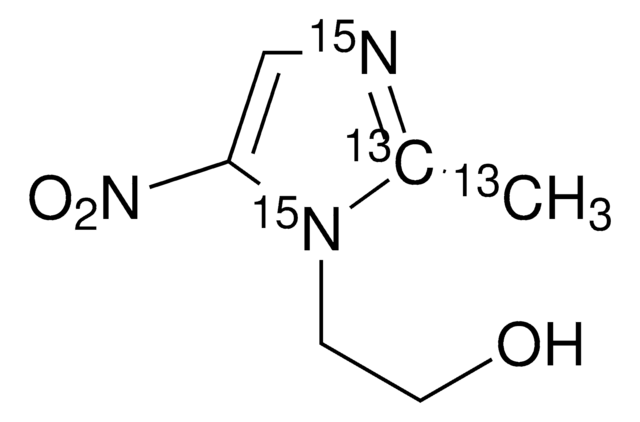M3761
Metronidazole
analytical standard
Synonym(s):
2-Methyl-5-nitroimidazole-1-ethanol
About This Item
Recommended Products
grade
analytical standard
Quality Level
form
crystalline
technique(s)
HPLC: suitable
gas chromatography (GC): suitable
mp
159-161 °C (lit.)
antibiotic activity spectrum
Gram-negative bacteria
parasites
application(s)
forensics and toxicology
pharmaceutical (small molecule)
format
neat
Mode of action
DNA synthesis | interferes
storage temp.
2-8°C
SMILES string
CC1=NC=C([N+]([O-])=O)N1CCO
InChI
1S/C6H9N3O3/c1-5-7-4-6(9(11)12)8(5)2-3-10/h4,10H,2-3H2,1H3
InChI key
VAOCPAMSLUNLGC-UHFFFAOYSA-N
Looking for similar products? Visit Product Comparison Guide
General description
Application
- Cyclic voltametric determination of metronidazole at carbon paste electrode (CPE) in three different brands of metronidazole tablets
- Simultaneous determination of metronidazole, diloxanide, spiramycin, and cliquinol in pharmaceutical dosage forms by reversed-phase high-performance liquid chromatography coupled to photodiode array detector (RP-HPLC-DAD)
- Development of an electrochemical sensor based on polydopamine/carboxylic multi-walled carbon nano-tubes (MWCNTs-COOH) nanocomposites for the determination of metronidazole
- Liquid chromatography–ion trap mass spectrometry (LC-MS/MS based analysis of metronidazole in water, sediment, and fish tissue samples
- Determination of metronidazole using an electrochemical sensor based on multi-walled carbon nanotubes (MWCNTs) and chitosan-nickel complexes (CTS-Ni) in tablets, human urine, and serum samples
Other Notes
Signal Word
Danger
Hazard Statements
Precautionary Statements
Hazard Classifications
Carc. 1B - Muta. 1B - STOT RE 2
Storage Class Code
6.1C - Combustible acute toxic Cat.3 / toxic compounds or compounds which causing chronic effects
WGK
WGK 3
Flash Point(F)
Not applicable
Flash Point(C)
Not applicable
Personal Protective Equipment
Choose from one of the most recent versions:
Already Own This Product?
Find documentation for the products that you have recently purchased in the Document Library.
Customers Also Viewed
Our team of scientists has experience in all areas of research including Life Science, Material Science, Chemical Synthesis, Chromatography, Analytical and many others.
Contact Technical Service







